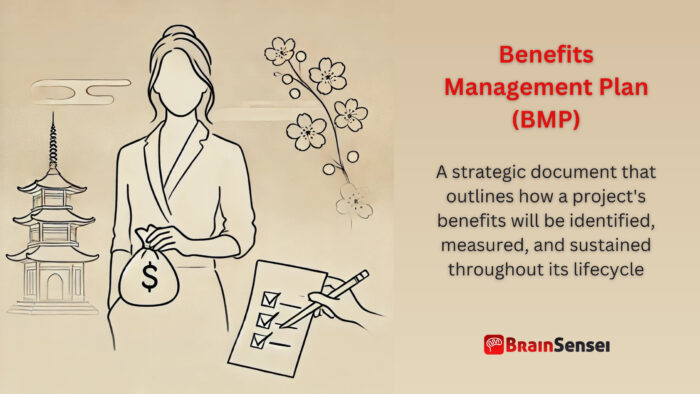
Benefits Management Plan
What is a Benefits Management Plan?
A benefits management plan (BMP) is a strategic document that outlines how a project’s benefits will be identified, measured, and sustained throughout its lifecycle. It provides a structured approach to ensure project outcomes align with organizational goals and deliver tangible value. This plan helps stakeholders track and evaluate benefits realization, ensuring long-term success.
Key Takeaways
- Defines expected project benefits and aligns them with strategic objectives.
- Establishes criteria for measuring benefits realization.
- Provides a roadmap for sustaining benefits beyond project completion.
- Enhances stakeholder confidence by demonstrating value delivery.
- Helps mitigate risks related to unfulfilled project expectations.
Understanding the Benefits Management Plan
How It Works
A Benefits Management Plan is developed during the planning phase of a project and updated as needed throughout its lifecycle. It typically includes:
- Benefits Identification: Defines expected benefits and links them to strategic goals.
- Benefits Quantification: Establishes measurable criteria for tracking progress.
- Realization Timeline: Defines when the team should achieve benefits.
- Roles & Responsibilities: Assigns accountability for benefits delivery and monitoring.
- Measurement & Reporting: Outlines methods for assessing benefits over time.
- Sustainability Plan: Ensures benefits continue post-project closure.
Notes
- The team should review the BMP periodically to adapt to changes in project scope or business environment.
- It should be integrated with risk management to address potential obstacles to realizing benefits.
- Project teams must actively engage stakeholders to ensure alignment with business needs.
- A well-defined BMP contributes to better decision-making and resource allocation.
- Failing to track benefits can create the perception of project failure, even if the team completed deliverables.
Related Terms
- Business Case: A document that justifies a project’s viability, including expected benefits.
- Benefits Realization Management (BRM): The framework for identifying, planning, measuring, and sustaining project benefits to ensure they align with business objectives and deliver intended outcomes.
- Key Performance Indicators (KPIs): Measurable values that indicate benefit achievement.
- Value Management: Maximizing the benefits and value derived from a project.
- Change Management: Managing changes to ensure continued alignment with benefits objectives.
- Project Charter: A high-level document that outlines a project’s purpose and expected benefits.
Examples of Benefits Management Plan
Construction Industry
A construction company launching a new residential development includes a Benefits Management Plan (BMP) to ensure the project delivers financial and social benefits. The BMP outlines revenue projections, community impact assessments, and sustainability measures, ensuring long-term value for stakeholders. It also tracks home sales, environmental impact reports, and economic contributions to the local workforce. The BMP helps ensure that the project does not merely focus on completion but also its intended benefits, such as job creation and affordable housing.
Healthcare Sector
A hospital implementing an electronic medical records (EMR) system creates a BMP to track improvements in patient care, efficiency gains, and cost reductions. The plan includes performance metrics such as reduced wait times, increased data accuracy, and fewer administrative errors. Additionally, the BMP outlines plans for staff training, ensuring that medical professionals can maximize the system’s capabilities. By monitoring key benefits like improved patient outcomes and operational efficiency, the hospital can ensure that the investment in the EMR system delivers the expected advantages.
IT & Software Development
A software company developing a new enterprise application includes a Benefits Management Plan (BMP) to measure user adoption rates, productivity improvements, and revenue growth. The BMP ensures alignment with business goals and stakeholder expectations. It also includes structured benefits tracking, such as reduced processing times, enhanced customer satisfaction scores, and streamlined business operations. The post-implementation assessment phase helps identify and apply ongoing improvements to maximize return on investment (ROI). The company can sustain the project’s long-term value by continuously refining software updates based on user feedback.
Use Cases of Benefits Management Plan Implementation
United States (Government Infrastructure Project)
A federal agency in the U.S. launched a Benefits Management Plan for a national infrastructure initiative. The plan ensures that taxpayer funds are spent efficiently and tracks benefits such as job creation, economic impact, and environmental sustainability. By integrating data analytics and impact assessments, the agency ensures ongoing monitoring and adjustments to maintain optimal outcomes. Regular stakeholder meetings help align project goals with economic policies, and real-time reporting mechanisms provide transparency and accountability.
Europe (Financial Services)
A European bank implements a Benefits Management Plan while upgrading its digital banking system. The plan monitors customer satisfaction, operational efficiency, and regulatory compliance. The BMP establishes clear performance benchmarks, such as reducing customer transaction times and minimizing system downtimes. The bank also introduces employee training programs to ensure staff can fully leverage new technologies, maximizing internal efficiencies and customer service improvements. Moreover, periodic reviews help the bank address emerging cybersecurity threats and ensure continued regulatory adherence.
Asia (Manufacturing Industry)
A manufacturing company in Asia utilizes a BMP for a factory automation project. The plan quantifies benefits such as reduced production costs, improved safety, and increased output. The company outlines key success indicators, including reduced defect rates and enhanced machine uptime. Employee training programs ensure smooth transitions to automated processes, and a structured change management approach helps mitigate workforce resistance. Post-implementation reviews allow the company to refine processes and integrate emerging innovations to sustain long-term benefits.
Additionally, the BMP integrates with supply chain management, tracking real-time inventory and demand fluctuations to optimize production cycles. By aligning automation with business goals, the company enhances overall operational efficiency, reduces costs, and maintains high product quality. Regular audits and performance assessments help the company adapt to evolving industry trends and sustain its competitive advantage.
Best Practices for Implementing a Benefits Management Plan
Implementing a Benefits Management Plan requires a structured approach to ensure effectiveness. Best practices include:
- Ensuring benefits are realistic and measurable through key performance indicators (KPIs).
- Aligning benefits with strategic business objectives and adjusting to evolving priorities.
- Continuously reviewing and updating the plan to adapt to changing business environments.
- Assigning clear ownership for benefit tracking and ensuring accountability among stakeholders.
- Utilizing advanced data analytics to validate benefits realization and optimize future projects.
- Engaging key stakeholders through regular communication to ensure sustained commitment.
- Integrating benefits realization with risk management strategies to minimize unforeseen challenges.
- Implementing automated tracking systems to streamline benefit measurement and reporting.
- Providing ongoing training and development programs to ensure continuous improvement.
- Establishing a feedback loop that allows for iterative improvements in project execution.
A well-structured BMP enhances decision-making, resource allocation, and stakeholder engagement while ensuring that projects deliver sustainable value over the long term. By embedding benefits realization into the project lifecycle, organizations can maximize their return on investment and achieve long-term success.
Benefits Management Plan: Common Mistakes and Issues
One of the most common mistakes in benefits management planning is the failure to establish clear and measurable criteria for tracking benefits. Without well-defined KPIs, organizations struggle to determine whether a project has met its intended objectives. Additionally, organizations may overestimate potential benefits without considering external factors such as market fluctuations, regulatory changes, or technological advancements.
Another frequent issue is inadequate stakeholder engagement. If the team does not involve key stakeholders in defining and reviewing benefits, it may fail to address their needs and expectations adequately. Such issues often lead to resistance during implementation or a lack of commitment to sustaining benefits after completing the project.
Organizations often neglect post-project benefit realization and fail to track whether they achieve the expected benefits. After project completion, there may be insufficient follow-up to ensure that benefits continue to be delivered. Benefits may decline over time without regular monitoring and adjustments or fail to materialize entirely.
Another issue is poor alignment with business strategy. If the benefits outlined in a BMP do not align with organizational goals, the project may not deliver meaningful value. This issue can result in wasted resources and missed opportunities for strategic growth.
Organizations should establish clear measurement criteria to mitigate these challenges, actively engage stakeholders, conduct ongoing benefit realization reviews, and ensure that benefits remain aligned with the overall business strategy. These actions will maximize project value and long-term success.
Benefits Management Plan: Frequently Asked Questions (FAQs)
Why is a Benefits Management Plan important?
A BMP ensures that projects deliver tangible value, align with strategic goals, and maintain accountability for benefits realization.
Who is responsible for managing the Benefits Management Plan?
Project sponsors, business analysts, and project managers typically collaborate to develop and oversee the BMP.
How often should a BMP be updated?
A BMP should be reviewed regularly, especially after significant project milestones or organizational changes.
How does a BMP differ from a business case?
A business case justifies project approval, while a BMP focuses on tracking and sustaining the benefits after completion.
Can a Benefits Management Plan be applied to small projects?
Yes, even small projects can benefit from a structured BMP to ensure value realization.
Additional Resources
Preparing for a PMI certification?
- Exam Prep Courses: PMP®, CAPM®, and PMI-ACP®
- Exam Simulators: PMP®, CAPM®, PMI-ACP®, PMI-PBA®, PMI-RMP®, PMI-SP®, PgMP®, and PfMP®
- Professional Development Units (PDUs): 15, 30, and 60 PDU Bundles



